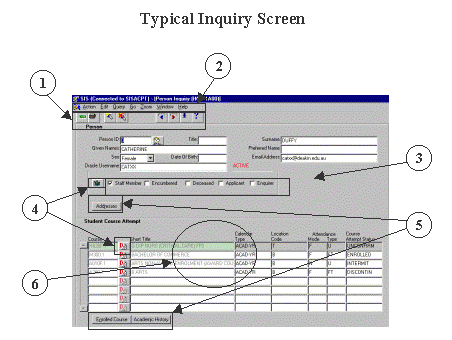|
|
|
|
|

| 1 | Toolbar |
|
| Used
to navigate around Callista's inquiry facility. Click on the picture to read how each icon is used. |
||
| 2 | Menu Bar | |
| Alternative way of executing toolbar commands. Refer also to Keyboard Shortcuts and Accelerator Keys. | ||
| 3 | Checkboxes | |
| Provide yes/no information. E.g. A tick or cross in the Staff member checkbox indicates YES - the person is a staff member, a blank checkbox means no. | ||
| 4 | Iconic Buttons | |
| Navigation buttons whose function is identified by an icon (representative picture). Clicking on a button usually displays another screen. | ||
| 5 | Navigation Buttons | |
| Navigation buttons with a text label. Clicking on a button usually displays another screen. Some buttons are 'greyed' indicating that they are inactive or that the function is not available. Some buttons have a plus or minus sign, in brackets, after their text label (e.g. Unit Level details [+]). Plus indicates that their is data to be displayed on the screen activated by the button, minus means that there is no data to be displayed. | ||
| 6 | Data Fields |  |
| Fields containing data. Most fields are labelled (in this case Calendar Type). Fields which are ‘highlighted’ in a different colour to other fields (green here) are part of the ‘currently selected’ record. A record is selected by clicking in one of its fields. |
Instructions:
To see information in a
blank screen you must execute a query by clicking the Query
button ![]() . A query may return more than one
record. Some screens display more than one record at a time with a scroll bar
to move through the records. Some screens display only one record at a time.
In this case, click on the Next Record icon
. A query may return more than one
record. Some screens display more than one record at a time with a scroll bar
to move through the records. Some screens display only one record at a time.
In this case, click on the Next Record icon ![]() to view the different
records.
to view the different
records.
A query can be refined so that less (or more relevant) records are returned, by entering query criteria (known data) in some of the fields on the screen and then clicking the query button. To execute a new query:
Any records matching the query will be returned to the screen. If no records exist in the database that match the query, a message confirming this is displayed in the bottom left hand corner of the screen.
The percentage sign (%) can and should be used as a wildcard in query criteria. For example, a search for Katherine Elisabeth Macleod could be problematic if the exact spelling of the given or surnames is not known or if she most commonly uses her middle name. Therefore to find this record when we think we are searching for Elizabeth McLeod we could enter query criteria such as Surname: M%LEOD and Given Names: %ELI%.
It is a wise precaution to always truncate query criteria and add a wild card unless absolutely certain of the format of the query criteria. For example, the code for an unconfirmed student course attempt status is UNCONFIRM. If UNCONFIRMED is entered or UNCONF (without a wild card), the required records cannot be displayed. In this case UNCON%, or similar, could be used.
Moving Between Screens
Most screens contain navigation buttons with either text or iconic labels. Clicking on one of these buttons displays a new screen in which different information can be viewed. To return to the previously displayed screen, click on the Back button if there is one on the current screen or click on the Exit icon on the toolbar. The Inquiry Navigation Map shows the different paths that can be followed between screens. The Help for each screen describes which screens are displayed when each of its buttons is clicked. Refer also to Zooms, below.
Some screens have zooms created for them which provide a quick way to navigate to other Inquiry screens and Callista data entry forms. Clicking on the Zoom item on the menu bar displays a list of screens and forms. Click on one of these to display that screen or form. Use the Exit button to return to the original screen. Further information about zooms is available in Callista's on-line manual.
Printing
To print what is currently displayed on a particular screen, click on the Print icon on the toolbar.
Most functions in Callista can be performed in three ways, either by clicking on a toolbar button, selecting a function from the menu bar or using a keyboard shortcut. A keyboard shortcut is a combination of keystrokes. They make it possible to use the keyboard rather than having to change to the mouse to perform system functions. Keyboard shortcuts relevant to the Inquiry Facility are:
| Function | Shortcut |
| Enter a query | F7 |
| Execute the query | F8 |
| Cancel query | Ctrl + q |
| Exit (return to previous form) | Ctrl
+ q or Alt + F4 (Cancel query first) |
| Next record | Down arrow |
| Previous record | Up arrow |
| Help | F1 |
| Display list of values | F9 |
| Ctrl + p |
Accelerator keys are combinations
of keystrokes used instead of clicking on menu items or navigation buttons.
Most menu items and navigation buttons have one character underlined. The accelerator
key in each case is the combination of Alt and the underlined character. e.g.
the accelerator key for this navigation button ![]() is Alt + i.
is Alt + i.
Getting Help
For help in using Callista's Inquiry facility refer to How to use Inquiry Help.
Toolbar Icons